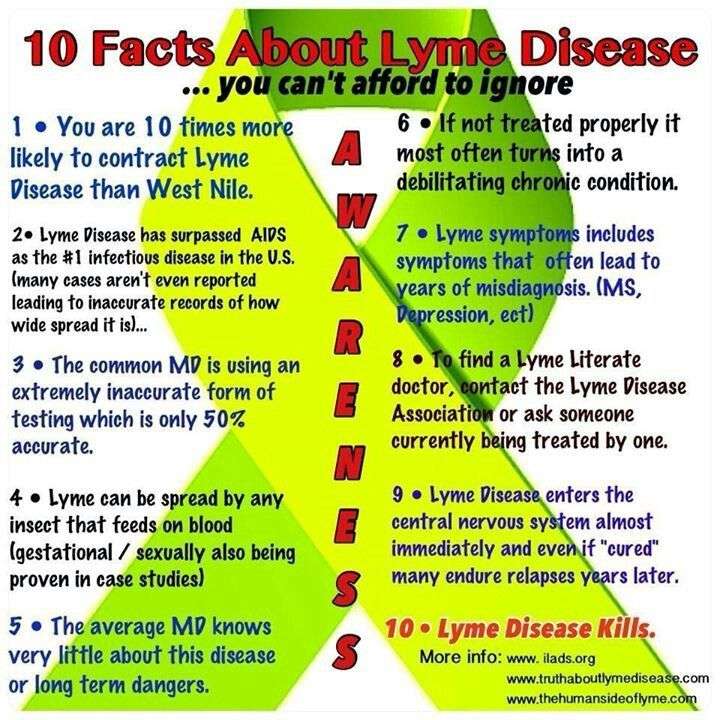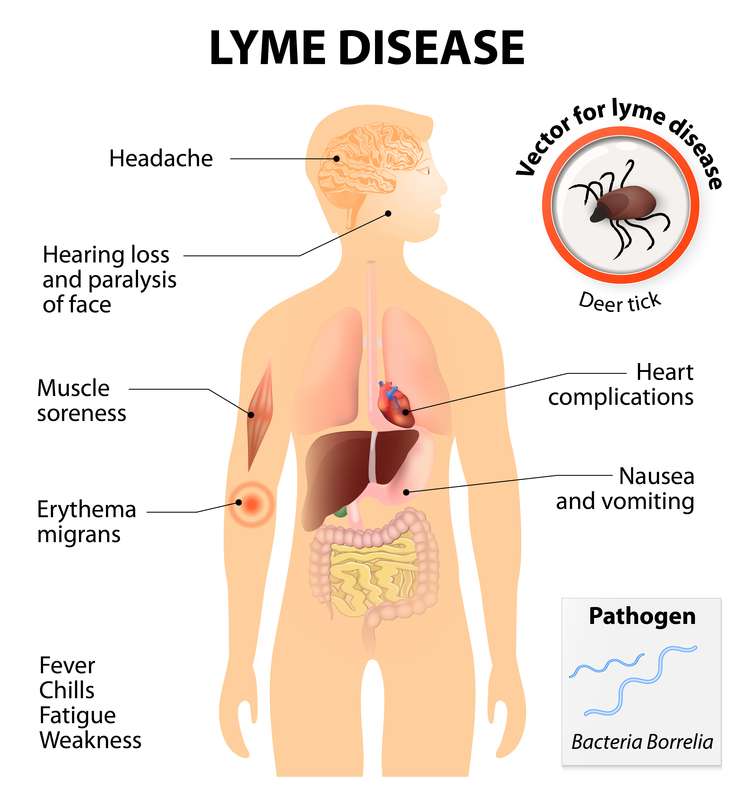Chronic Lyme Disease Patients Profoundly Debilitated
Many patients with chronic Lyme disease are profoundly debilitated. Investigators of the four NIH-sponsored retreatment trials documented that the patients quality of life was consistently worse than that of control populations and equivalent to that of patients with congestive heart failure. Pain levels were similar to those of post-surgical patients, and fatigue was on par with that seen in multiple sclerosis.
An LDo published survey of over 3,000 patients with chronic Lyme disease found that patients suffer a worse quality of life than most other chronic illnesses, including congestive heart failure, diabetes, multiple sclerosis and arthritis. Over 70% of patients with chronic Lyme disease reported fair or poor health. Similar results have been found in other studies. Many of the symptoms associated with Lyme disease are common in other diseases. The CDC surveillance criteria for confirmed cases specifically exclude most of the symptoms that patients report, including fatigue, sleep impairment, joint pain, muscle aches, other pain, depression, cognitive impairment, neuropathy, and headaches. However, these common symptoms can be severe and may seriously affect quality of life.
Questions To Ask Your Doctor
- I found a tick embedded in my skin, but I cant get it out. What should I do?
- Ive been bitten by a tick. Do I need to be seen?
- Do I need a blood test to confirm Lyme disease?
- Which antibiotic is best for me?
- How long will I have to take the antibiotic?
- What tick or insect repellent should I use for me or my child?
- How long will the symptoms last?
- What should I do if I still dont feel well a long time after I was bitten?
Lyme Has Two Growth States
Research published in 2015 shows that Lyme has two different growth states. There is a growing phase of the germs and there is a persister phase. Think of the persisters as germs that are in hibernation. These persisters – hibernating phase germs – ignore regular standard antibiotics we traditionally use to treat Lyme.
Read Also: Lyme Disease What Is It
What’s The Best Way To Prevent A Tick Bite
Ticks can’t fly or jump. But they live in shrubs and bushes and can grab onto you when you pass by. To avoid getting bitten:
- Wear pants and socks in areas with lots of trees and when you touch fallen leaves.
- Wear a tick repellent on your skin and clothing that has DEET, lemon oil, or eucalyptus.
- For even more protection, use the chemical permethrin on clothing and camping gear.
- Shower within 2 hours after coming inside. Look for ticks on your skin, and wash ticks out of your hair.
- Put your clothing and any exposed gear into a hot dryer to kill whatever pests might be on them.
How do you know if you’ve been bitten?
Since ticks are so small, you’ve got to have pretty good eyes to see them.
If you have a small, red bump on your skin that looks like a mosquito bite, it could be a tick bite. If it goes away in a few days, itâs not a problem. Remember, a tick bite doesnât necessarily mean you have Lyme disease.
If you notice a rash in the shape of a bull’s-eye, you might have a tick bite. Talk to your doctor about treatment.
If you have an allergic reaction to ticks, you’ll notice a bite right away.
Natural Remedies For Lyme Disease

Lyme disease is a bacterial infection caused by the bacterium Borrelia burgdorferi. It is spread through the bite of infected ticks.
Ticks are very small, and their biteswhich can occur anywhere on the bodyare usually painless, so you may not immediately be aware that you have been bitten. In most cases, the tick must be attached to the body for 24 hours before Lyme disease is transmitted.
The signs and symptoms of Lyme disease usually start within three to 30 days after youve been bitten by an infected tick. Many people experience flu-like symptoms after being bitten, while more serious symptoms show up weeks after the bite. Early signs and symptoms of Lyme disease include:
- Chills
- Rash
- Swollen lymph nodes
If left untreated, symptoms can worsen to include Bells palsy , severe headaches, muscle, joint, and tendon pain, cardiac problems, and neurological disorders.
Most cases of Lyme disease can be managed and treated with two to three weeks of antibiotics. Depending on the severity of your symptoms and how long after the bite you were diagnosed, you may need a longer course of antibiotics to clear up the infection. Many people turn to natural remedies to help treat Lyme disease.
Don’t Miss: Deer Ticks Carry Lyme Disease
Potential Treatment For Lyme Disease Kills Bacteria That May Cause Lingering Symptoms Study Finds
Screening thousands of drugs, Stanford scientists determined that in mice, azlocillin, an antibiotic approved by the Food and Drug Administration, eliminated the bacteria that causes Lyme disease.
Deer ticks are vectors of Borrelia burgdorferi, the bacteria that causes Lyme disease.Scott Bauer/USDA Agricultural Research Service
For decades, the routine treatment for Lyme disease has been standard antibiotics, which usually kill off the infection. But for up to 20% of people with the tick-borne illness, the antibiotics dont work, and lingering symptoms of muscle pain, fatigue and cognitive impairment can continue for years sometimes indefinitely.
A new Stanford Medicine study in lab dishes and mice provides evidence that the drug azlocillin completely kills off the disease-causing bacteria Borrelia burgdorferi at the onset of the illness. The study suggests it could also be effective for treating patients infected with drug-tolerant bacteria that may cause lingering symptoms.
This compound is just amazing, said Jayakumar Rajadas, PhD, assistant professor of medicine and director of the Biomaterials and Advanced Drug Delivery Laboratory at the Stanford School of Medicine. It clears the infection without a lot of side effects. We are hoping to repurpose it as an oral treatment for Lyme disease. Rajadas is the senior author of the study, which was published online March 2 in Scientific Reports. The lead author is research associate Venkata Raveendra Pothineni, PhD.
Lyme Disease Treatment: 2 Herbal Compounds May Beat Antibiotics
Lyme disease transmitted via tick bite affects thousands of people in the United States and around the world. Currently, doctors use antibiotics to treat it, but could plant-based remedies be more effective?
Lyme disease is an infectious disease caused by the bacterium Borrelia burgdorferi .
The disease spreads to humans through the bite of a tick that carries the bacterium, and it affects an estimated each year in the U.S. alone.
Currently, healthcare professionals choose between three antibiotics in the treatment of Lyme disease. These are doxycycline, cefuroxime, and amoxicillin.
Sometimes, however, antibiotics are not effective in eradicating all traces of B. burgdorferi from the system, which means that the disease can persist.
When this happens, bacterial cells that have developed antibiotic resistance can continue to proliferate. These are known as persister cells .
Because of this, researchers have been looking into alternative modes of fighting the bacterium, and their first line of inquiry has focused on natural remedies.
In 2018, an in vitro study suggested that 10 plant-derived essential oils could help fight off B. burgdorferi.
Now, researchers from the Johns Hopkins Bloomberg School of Public Health in Baltimore, MD, and from the California Center for Functional Medicine and Focus Health in Berkeley, have conducted a new study that has led them to believe that two specific plants may lead to more effective therapies against Lyme disease.
Read Also: Lyme Booster Shot For Dogs
About Intestinal Parasites In Lyme Disease
Consider treating for intestinal parasites in Lyme disease because they lead the immune system to produce too many cytokines. Cytokines create fatigue, body pain, poor thinking, and the whole range of symptoms seen in Lyme disease. Not only does Lyme trigger these cytokines, but other infections, as well, such as intestinal parasites can trigger cytokines. Read more about cytokines and steps you can take to lower them in Control Cytokines: A Guide to Fix Lyme Symptoms & The Immune System.
The problem with intestinal parasites is that they are difficult to diagnose. The way most doctors test for parasites is to perform a microscope stool exam. However, studies show that depending on the kind of parasite, testing can work anywhere from 20 to 90 percent of the time. This means that testing is very poor and not reliableif the test result is negative.
Additionally, hidden parasites are a major cause of ongoing fatigue and dysfunction. In 1990, Leo Galland, MD showed that 50 percent of people with chronic fatigue syndrome had intestinal parasite infections that were missed by physicians.
Herbal And Prescription Antimicrobials By Function
Be aware the doses I provide below are for adults. These same prescriptions can be used with children but have lower doses. For pediatric dosing, talk with your family physician or pediatrician. Tetracyclines can be used in children under eight, but there is a risk of tooth staining. This staining seems not to be an issue if they are used for a month or less.
You May Like: Lyme Disease Ever Go Away
Symptoms Of Lyme Disease
A circular or oval shape rash around a tick bite can be an early symptom of Lyme disease in some people.
The rash can appear up to 3 months after being bitten by an infected tick, but usually appears within 1 to 4 weeks. It can last for several weeks.
The rash can have a darker or lighter area in the centre and might gradually spread. It’s not usually hot or itchy.
The rash may be flat, or slightly raised, and look pink, red, or purple when it appears on white skin. It can be harder to see the rash on brown and black skin and it may look like a bruise.
Some people also get flu-like symptoms a few days or weeks after they were bitten by an infected tick, such as:
- a high temperature, or feeling hot and shivery
- headache
- tiredness and loss of energy
Some people with Lyme disease develop more severe symptoms months or years later.
This is more likely if treatment is delayed.
These more severe symptoms may include:
- pain and swelling in joints
- nerve problems such as pain or numbness
- heart problems
- trouble with memory or concentration
The Chance Of Getting Lyme Disease
Not all ticks in England carry the bacteria that causes Lyme disease.
But it’s still important to be aware of ticks and to safely remove them as soon as possible, just in case.
Ticks that may cause Lyme disease are found all over the UK, but high-risk places include grassy and wooded areas in southern and northern England and the Scottish Highlands.
Ticks are tiny spider-like creatures that live in woods, areas with long grass, and sometimes in urban parks and gardens. They’re found all over the UK.
Ticks do not jump or fly. They attach to the skin of animals or humans that brush past them.
Once a tick bites into the skin, it feeds on blood for a few days before dropping off.
Read Also: Best Infrared Sauna For Lyme Disease
What To Expect At Home
Home care for dogs with Lyme disease is relatively straightforward. Doxycycline is usually given by mouth twice daily for at least 30 days. Improvement in the dogs symptoms should be noted within 24-48 hours. If the dogs condition fails to improve in 72 hours or worsens at any time, call your veterinarian.
What To Expect At The Vets Office

If your pet has been diagnosed with uncomplicated Lyme disease, this is what you can expect to happen at your veterinarians office.
- Depending on the type of test used to screen for Lyme disease, a confirmatory test may be necessary.
- Urine protein screening — In general, only dogs who have symptoms of Lyme disease or protein in their urine should be treated with antibiotics.
- Dogs with protein in their urine should have regularly scheduled rechecks to monitor their condition.
Also Check: Does Lyme Disease Stay With You Forever
How To Tell If A Tick Carries Lyme Disease
How To Know If Its Lyme Disease. Not every tick carries the disease, but there are a few early signs to watch for. If you exhibit any of these, it is important to contact your medical professional immediately and seek treatment. Bullseye rash A rash will appear surrounding the bite area in a near perfect circle.
Late Or Chronic Lyme Disease Treatment
Experts agree that the earlier you are treated the better, since early treatment is often successful. Unfortunately, a substantial portion of patients treated with short-term antibiotics continue to have significant symptoms. The quality of life of patients with chronic Lyme disease is similar to that of patients with congestive heart failure. Doctors dont agree about the cause of these ongoing symptoms. The primary cause of this debate is flawed diagnostic testing. There is currently no test that can determine whether a patient has active infection or whether the infection has been eradicated by treatment.
The IDSA thinks Lyme disease symptoms after treatment represent a possibly autoimmune, post-Lyme syndrome that is not responsive to antibiotics. The IDSA essentially regards Lyme disease as an acute infection like strep throat that can be treated with a short course of antibiotics. The IDSA guidelines are now eight years old and do not reflect recent science.
ILADS physicians believe that ongoing symptoms probably reflect active infection, which should be treated until the symptoms have resolved. These physicians use treatment approaches employed for persistent infections like tuberculosis, including a combination of drugs and longer treatment durations. The ILADS guidelines have just recently been updated using a rigorous review of the medical literature.
You May Like: Dr Nader Soliman Lyme Disease
Considerations While On Lyme Treatment
Antibiotics can wipe out beneficial intestinal flora, leading to a wide variety of additional health problems. It is important to take probiotics while on antibiotics to maintain a healthy balance of gut bacteria. Furthermore, antibiotics may interact with other drugs, supplements or food. The National Institutes of Healths MedLinePlus website gives information about drug interactions.
Can A Single Nymphal Tick Bite Transmit Lyme Disease
While some mouse studies suggest that a single nymphal tick bite cannot transmit Lyme disease in less than 24 hours, others dispute this finding. Eisen states, the possibility that transmission of Lyme disease spirochetes could occur within 24 hours of nymphal attachment under unusual circumstances should not be discounted.
Also Check: Unusual Symptoms Of Lyme Disease
Herbs For Lyme Disease Treatment
Herbs have been used as a medicinal treatment for thousands of years. Many people have turned to herbal remedies to help provide relief from Lyme disease when antibiotics didn’t completely help eliminate symptoms.
One research study found that a combination of doxycycline and baicalein provides additional healing benefits. According to a 2020 laboratory study, seven herbal medicines have been shown to kill B. burgdorferi in test tubes:
- Cryptolepis sanguinolenta
- Scutellaria baicalensis
Garlic has antibacterial effects and may help prevent tick bites. One study determined that people who took garlic supplements reported fewer tick bites than the placebo group. Garlic essential oil has been shown to eliminate the bacterium that causes Lyme disease.
Garlic can interact with certain medications, so speak with your healthcare provider before using it to prevent or treat Lyme disease.
Steviaa natural sweetener and sugar substitute derived from the leaves of the Stevia rebaudiana plantmay be effective in treating Lyme disease. A study published in the European Journal of Microbiology and Immunology discovered that stevia extracts are more effective in killing Lyme disease bacterium in the lab than the standard antibiotics.
What Is Late Lyme Disease
Lyme disease, also known as Lyme borreliosis, is caused by an infection with the bacteria Borrelia burgdorferi. This bacteria is disseminated through tick bites. Infected ticks usually bite small mammals, who do not develop any kind of infection from the bacteria. When humans are exposed to B. Burgdorferi from a tick bite, however, they can develop Lyme disease.
People who work outside or spend time in woodland areas, where there is greater potential for exposure to tick bites, are most at risk of infection.
Lyme disease is a condition which progresses in stages:
You May Like: How Long Lyme Disease Last
What Is Tiredness Like With Lyme Disease
Tiredness, exhaustion, and lack of energy are the most frequent symptoms. The Lyme fatigue can seem different from regular tiredness, where you can point to activity as a cause. This fatigue seems to take over your body and can be severe. You may find yourself needing a nap during the day, or needing to sleep one or more hours longer than usual.
What Causes Lyme Disease

People get Lyme disease when they are bitten by an infected tick. Ticks live in areas with a lot of plant life, such as wooded areas or fields. They sit near the top of grassy plants and low bushes. They wait there for people or animals to brush up against them. Ticks can crawl on your clothes or body for up to several hours or more before attaching to the skin.
Ticks can attach to any part of your body. They are usually found in hard-to-see areas, including the armpits, groin, or scalp. An infected tick needs to be attached to your skin for 36 to 48 hours before it passes the bacteria on to you.
People who spend time in outdoor areas where ticks are common are at higher risk of getting tick-borne diseases.
Read Also: How Do You Contract Lyme Disease